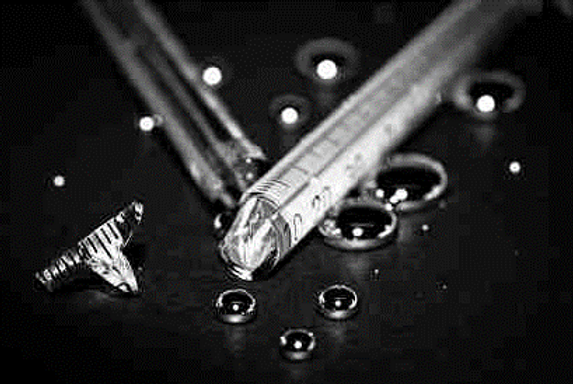Last time we discussed High Hg upon Startup after a planned or unplanned outage. If you missed it, be sure to check out that blog post. In this blog post we are going to address the issue of equipment contamination that has the potential to bias your Hg results higher than expected.

Pattern #2: Could your equipment be contaminated and contributing to High Hg Levels?
THE TRAPS
Store your sorbent traps in a location where you are certain Hg ambient levels are minimal! Sorbent traps are not air-tight so there is a possibility for Hg permeation from the environment. We have seen instances where a customer reported high background levels on virgin sorbent traps and then realized that they were storing the traps in a vehicle which previously had a mercury spill.
Don’t store the traps near sampling equipment that may be contaminated either. Please audit your environment by renting an ambient air analyzer, utilizing your M324 Spectrometer for ambient air analysis (contact us for details), or setting up a simple sorbent trap sampling system and sampling some traps in the location temporarily. Also, analyze virgin traps every once in a while, to confirm that nothing has changed.
THE SHROUD
Many customers are sampling post wet FGDs. It is imperative to keep traps dry, so customers are utilizing probe shields or shrouds. These allow for traps to sit recessed a few inches with a metal umbrella protecting them from direct moisture entrainment. But did you know that the shroud or shield could become a source of mercury if it is not cleaned or swapped with each trap change-out? Since this is often a saturated environment, the moisture will release mercury from the particulate or sludge build-up on the shroud in the form of vapor phase oxidized or elemental mercury. Some of the oxidized mercury released from this source may be captured on the front plug; however, much of it will be captured on the first carbon section over a typical seven-day run.
Suddenly, a source that usually has a mercury concentration lower than 1ug/dscm has a much higher Hg concentration than expected. Over time, it seems to get worse and worse and is minimally affected by additional activated carbon or calcium bromide injection. In this case, the best advice we can give you is to clean your shroud-or even better, have a second shroud readily available to swap with each trap change-out.
Recently one of our customers ran into a situation during a RATA. The PS12B system was utilizing a shroud that had not been cleaned in over six months. The runs resulted in a concentration of 12ug/dscm, and the corresponding 30B traps (which did not use a shroud) resulted in measurements of less than 1 ug/dscm. Like magic, once the dirty shroud was removed, the numbers matched up.
Another plant recently saw the same issue. They were using a long shroud to prevent moisture entrainment that was vaporizing in the probe, resulting in aerosols (tiny droplets of water that carry oxidized mercury). These aerosols were releasing oxidized mercury and biasing the numbers high. After adding a sulfide to the FGD, the plant was able to further validate this theory by lowering the amount of mercury in the liquid phase. Now, they are getting good results using a smaller shroud.
By either cleaning or replacing your shroud on a regular basis, you’ll be taking a quick and easy step that may make all the difference in ensuring accurate results!
THE PROBE
Like the shroud, the probe itself can become a source! Bear in mind where the probe was last used (High Hg Gold Roaster?) Consider checking your probe, storage cases, vehicles, and other equipment for contamination and then taking it all through a decontamination procedure. Here is how we do it!
Detection
The Ohio Lumex RA915M ambient air analyzer can be used to quickly detect contaminated air inside cases, boxes, and Hg gassing off of probes and other equipment. However, there most likely will be Hg in oxidized form attached to surfaces and particulate on surfaces of the equipment.
This contamination can only be detected using the swab method. Using clean utensils, take a small glass wool swab, drop a couple drops of clean water, and swab across the potentially contaminated surfaces. We typically swab three times across the longest surfaces of cases or three times along the length of a probe.
The glass wool swab then gets rolled in a clean piece of foil and analyzed in an M-324 system. (If you don’t own an M324 analyzer, just contact us, we analyze materials all the time and would be happy to analyze your wipe samples.) Any sample over 10ng is considered contaminated. 10ng might be overkill for some locations and customers should use their discretion whether a higher Hg mass on a wipe sample is acceptable for the location where they are doing testing. If this equipment is to be used at low level sources in the future, then 10ng on a wipe sample is appropriate.
Hg Decontamination
Sulfurated Potash dissolved in water can be used to decontaminate equipment. We put a nickel sized piece of Sulfurated Potash in a large spray bottle filled with water, shake it up, and generously spray the solution all over the equipment. Let the solution sit and react on the surfaces for about an hour. After that wash the solution off with water. If possible, use a pressure washer. Heavily contaminated equipment will need more treatments. Repeat the swab test after every treatment until decontaminated. We treat the equipment until the swab test shows under 10ng because handling equipment with any more contamination can ruin pair agreements and breakthrough quality control of sorbent trap runs.
Contact us today for more details on how we can help you!
Miss part of the series? Check out a few of our other blog posts on elevated Hg levels:

